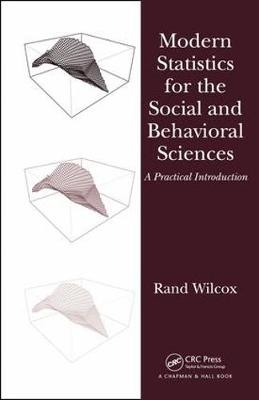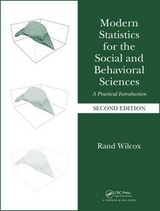
Modern Statistics for the Social and Behavioral Sciences
Crc Press Inc (Verlag)
978-1-4398-3456-5 (ISBN)
- Titel erscheint in neuer Auflage
- Artikel merken
Designed for a two-semester, introductory course for graduate students in the social sciences, this text introduces three major advances in the field:
Early studies seemed to suggest that normality can be assumed with relatively small sample sizes due to the central limit theorem. However, crucial issues were missed. Vastly improved methods are now available for dealing with non-normality.
The impact of outliers and heavy-tailed distributions on power and our ability to obtain an accurate assessment of how groups differ and variables are related is a practical concern when using standard techniques, regardless of how large the sample size might be. Methods for dealing with this insight are described.
The deleterious effects of heteroscedasticity on conventional ANOVA and regression methods are much more serious than once thought. Effective techniques for dealing heteroscedasticity are described and illustrated.
Requiring no prior training in statistics, Modern Statistics for the Social and Behavioral Sciences provides a graduate-level introduction to basic, routinely used statistical techniques relevant to the social and behavioral sciences. It describes and illustrates methods developed during the last half century that deal with known problems associated with classic techniques. Espousing the view that no single method is always best, it imparts a general understanding of the relative merits of various techniques so that the choice of method can be made in an informed manner.
INTRODUCTION
Samples versus Populations
Software
R Basics
NUMERICAL AND GRAPHICAL SUMMARIES OF DATA
Basic Summation Notation
Measures of Location
Measures of Variation or Scale
Detecting Outliers
Histograms
Kernel Density Estimators
Stem-and-Leaf Displays
Skewness
Choosing a Measure of Location
Covariance and Pearson’s Correlation
Exercises
PROBABILITY AND RELATED CONCEPTS
Basic Probability
Expected Values
Conditional Probability and Independence
Population Variance
The Binomial Probability Function
Continuous Variables and the Normal Curve
Understanding the Effects of Non-normality
Pearson’s Correlation and the Population Covariance
Some Rules About Expected Values
Chi-Squared Distributions
Exercises
SAMPLING DISTRIBUTIONS AND CONFIDENCE INTERVALS
Random Sampling
Sampling Distributions
A Confidence Interval for the Population Mean
Judging Location Estimators Based on Their Sampling Distribution
An Approach to Non-normality: The Central Limit Theorem
Student’s t and Non-normality
Confidence Intervals for the Trimmed Mean
Transforming Data
Confidence Interval for the Population Median
A Remark About MOM and M-Estimators
Confidence Intervals for the Probability of Success
Exercises
HYPOTHESIS TESTING
The Basics of Hypothesis Testing
Power and Type II Errors
Testing Hypotheses about the Mean When σ Is Not Known
Controlling Power and Determining n
Practical Problems with Student’s T Test
Hypothesis Testing Based on a Trimmed Mean
Testing Hypotheses About the Population Median
Making Decisions About Which Measure of Location To Use
Exercises
REGRESSION AND CORRELATION
The Least Squares Principle
Confidence Intervals and Hypothesis Testing
Standardized Regression
Practical Concerns About Least Squares Regression and How They Might Be Addressed
Pearson’s Correlation and the Coefficient of Determination
Testing H0: ρ = 0
A Regression Method for Estimating the Median of Y and Other Quantiles
Detecting Heteroscedasticity
Concluding Remarks
Exercises
BOOTSTRAP METHODS
Bootstrap-t Method
The Percentile Bootstrap Method
Inferences About Robust Measures of Location
Estimating PowerWhen Testing Hypotheses About a Trimmed Mean
A Bootstrap Estimate of Standard Errors
Inferences about Pearson’s Correlation: Dealing with Heteroscedasticity
Bootstrap Methods for Least Squares Regression
Detecting Associations Even When There Is Curvature
Quantile Regression
Regression: Which Predictors are Best?
Comparing Correlations
Empirical Likelihood
Exercises
COMPARING TWO INDEPENDENT GROUPS
Student’s T Test
Relative Merits of Student’s T Test
Welch’s Heteroscedastic Method for Means
Methods for Comparing Medians and Trimmed Means
Percentile Bootstrap Methods for Comparing Measures of Location
Bootstrap-t Methods for Comparing Measures of Location
Permutation Tests
Rank-Based and Nonparametric Methods
Graphical Methods for Comparing Groups
Comparing Measures of Scale
Methods for Comparing Measures of Variation
Measuring Effect Size
Comparing Correlations and Regression Slopes
Comparing Two Binomials
Making Decisions About Which Method To Use
Exercises
COMPARING TWO DEPENDENT GROUPS
The Paired T Test
Comparing Robust Measures of Location
Handling Missing Values
A Different Perspective When Using Robust Measures of Location
R Functions loc2dif and l2drmci
The Sign Test
Wilcoxon Signed Rank Test
Comparing Variances
Comparing Robust Measures of Scale
Comparing All Quantiles
Plots for Dependent Groups
Exercises
ONE-WAY ANOVA
Analysis of Variance for Independent Groups
Dealing with Unequal Variances
Judging Sample Sizes and Controlling Power When Data Are Available
Trimmed Means
Bootstrap Methods
Random Effects Model
Rank-Based Methods
R Function kruskal.test
Exercises
TWO-WAY AND THREE-WAY DESIGNS
Basics of a Two-Way ANOVA Design
Testing Hypotheses About Main Effects and Interactions
Heteroscedastic Methods for Trimmed Means, Including Means
Bootstrap Methods
Testing Hypotheses Based on Medians
A Rank-Based Method For a Two-Way Design
Three-Way ANOVA
Exercises
COMPARING MORE THAN TWO DEPENDENT GROUPS
Comparing Means in a One-Way Design
Comparing Trimmed Means When Dealing with a One-Way Design
Percentile Bootstrap Methods for a One-Way Design
Rank-Based Methods for a One-Way Design
Comments on Which Method to Use
Between-by-Within Designs
Within-by-Within Design
Three-Way Designs
Exercises
MULTIPLE COMPARISONS
One-Way ANOVA, Independent Groups
SOME MULTIVARIATE METHODS
Location, Scatter, and Detecting Outliers
One-Sample Hypothesis Testing
Two-Sample Case
MANOVA
A Multivariate Extension of the Wilcoxon-Mann-Whitney Test
Rank-Based Multivariate Methods
Multivariate Regression
Principal Components
Exercises
ROBUST REGRESSION AND MEASURES OF ASSOCIATION
Robust Regression Estimators
Comments on Choosing a Regression Estimator
Testing Hypotheses When Using Robust Regression Estimators
Dealing with Curvature: Smoothers
Some Robust Correlations and Tests of Independence
Measuring the Strength of an Association Based on a Robust Fit
Comparing the Slopes of Two Independent Groups
Tests for Linearity
Identifying the Best Predictors
Detecting Interactions and Moderator Analysis
ANCOVA
Exercises
BASICMETHODS FOR ANALYZING CATEGORICAL DATA
Goodness of Fit
A Test of Independence
Detecting Differences in the Marginal Probabilities6
Measures of Association
Logistic Regression
Exercises
ANSWERS TO SELECTED EXERCISES
TABLES
BASIC MATRIX ALGEBRA
REFERENCES
Index
| Erscheint lt. Verlag | 16.8.2011 |
|---|---|
| Zusatzinfo | 105 Tables, black and white; 75 Illustrations, black and white |
| Verlagsort | Bosa Roca |
| Sprache | englisch |
| Maße | 156 x 234 mm |
| Gewicht | 1361 g |
| Themenwelt | Geisteswissenschaften ► Psychologie ► Allgemeine Psychologie |
| Mathematik / Informatik ► Mathematik ► Statistik | |
| Sozialwissenschaften ► Soziologie ► Empirische Sozialforschung | |
| ISBN-10 | 1-4398-3456-3 / 1439834563 |
| ISBN-13 | 978-1-4398-3456-5 / 9781439834565 |
| Zustand | Neuware |
| Haben Sie eine Frage zum Produkt? |
aus dem Bereich



